Face to Face
 The apparition of these faces in the crowd; / Petals on a wet, black bough. Ezra Pound
The apparition of these faces in the crowd; / Petals on a wet, black bough. Ezra PoundSociologist Richard Sennett's Flesh and Stone (1996) gives a strange history of interaction. Deploring the death of human contact in public, Sennett blames modern loneliness upon Greek masculinity, the Christian church, urban planning, and indeed capitalism's fear of the poor.
Such arguments raise profound questions for the way we live: is loneliness a human condition? or have modern people, divided by suburbs and cubicles, removed themselves from strangers to a degree unprecedented in other ages? History lends some answers. In The Road to Rule (Harvard University Press, 2011), I show that strangers stopped speaking to each other on the public streets of nineteenth-century Britain as middle-class travelers began to rely on guidebooks and maps for wayfinding advice they once received face-to-face from strangers. In other articles, I've examined the shift of body language and changing repertoires for reading strangers' faces.
But writers become sensitive to habits of interaction by living in a body in the world, not by books alone. ChatRoulette is an online website that randomly assigns your video camera to another party. There are dorm rooms, people masturbating, and dance studios -- wherever people happen to be -- from all around the world. Enter and you could find yourself looking into any of the nations where the internet is cheap: Japan, Boston, or Ireland. Go and you'll find a disproportionate number of men, a series few black screens (where the user wants to see you but won't show himself); and a large number of penises in the process of being jerked off.
But click past these gatekeepers and you might find yourself looking straight at the face of a stranger. Not in the eyes; both of you are almost certainly looking into the computer screen, not its camera. But there they are, in real time, the stranger's face, looking back at you.
You find yourself gazing into the face of strangers intently, studying teeth, hair, eyes, and smiles. People are too nervous on chatroulette to say much at first: what one really wants to do is stare at the face. After a string of penises another shy face, slightly amused, comes as a welcome surprise. For a few minutes you just look at the other person's laughing eyes, flickering from camera to screen, both of you amused to find another person with clothes on. The shape of the eyes, the face leaning towards you, the motions of a laugh are mostly silent, because most of us have terrible microphones in our computers. So we look and look, and then if we take up courage, if the person isn't to sour or somber, maybe we bend towards the keyboard and type, "How are you?" Contact is all about the face.
Three days ago I found myself giggling face-to-face with a twenty-year-old in Berlin who had just gotten off the night shift. It was 2am in Boston and 8am in Berlin, and there was sunlight coming through the window of the other room. We didn't have much to say to each other, but there was a full fifteen minutes of staring at each others' faces, lively, grinning, eyes moving, the pure delight of connection.
It takes a new technology to see a face a different way, to open up the room for longings otherwise suppressed or forgotten. How little did I know I wanted so much to gaze, to be gazed upon; to be seen. For two full days I thought only about that smile.
In The Railway Journey (1987), historian Wolfgang Schivelbusch argued that nineteenth-century trains were the first place where large numbers of strangers sat facing each other in silence. The experience created, he argued, the strange phenomenon of strangers looking at each other without saying anything. Thomas de Quincey's rambles in nineteenth-century London reflected another aspect to that silence: the strange sobriety of strangers on the streets in London, careful not to crack a smile or break a stride. Each face was frozen in the aspect of concrete: two windows looking out, nothing looking in. Strangers locked eyes to their mutual embarrassment. On the Tube people stare at the floor. A book is a comfort, a retreat.
In the city a few days later, I realize how little I gaze in everyday life. Philosopher Edward Casey, in his monumental study The World at a Glance (2007), asserts that the gaze of cinema is a rarity in human history, founded mainly upon the furtive glances, the fleeting snapshots of strangers' expressions and gestures. Early cinema scholars equated gazing with bought luxury, the privilege of the man in the box-seat staring at the woman on the stage, or the privilege of moneyed people staring through department-store windows. The intimacy of the face is something most of us only have with movie stars, whose pores and creases we know in detail. The luxury of gazing and gazing at another living face -- and of being gazed back upon -- is like drinking in the magic of cinema. More: it's like *being* the magic of cinema. It's the opportunity of being enchanted with someone else's pure personhood. It is not their ideas, their voice, their touch, their beauty that are transmitted through the tiny screens and dodgy cameras: it's their sure presence, their strange daring, for being alone with a stranger, for letting their face be studied. I find myself stopping at the face that says, "I am here! How crazy is that?" My shy smile back asks: "How funny is it that we're staring?"
So this human gaze is something special, historically speaking: the chance to look face to face, rather than through a glance fleetingly, at the lines of strangers' faces. We gaze at icons, moviestars, and children. The intimacy of gazing is too much, too scary, to entertain with adults. God forbid you study the face of a stranger on the bus or in the cafe.
Even in love, most of us blush and become calm when our partner breaks the stare to turn towards our feet or hair. Even among friends, we change topics that cut too close; we relieve the burden of presence by playing games or eating or telling stories. When do we stare?
Mostly, even on chatroulette, one does not stare; either party has the option of selecting "next" and being propelled to the next screen. I glance at nervous twenty-year-olds and immediately hit "next," downright afraid of being face-to-face with expressions so raw, so scared; as if looking any longer at their faces could put me in their condition.
We see through a glass darkly, says the Bible. How long will chatroulette remain a novelty, an opportunity for seeing people anew? For how many people does it actually operate that way? For a moment now, we see face-to-face. As we fill our screens with ephemeral windows that studies tell us sap our attention span, the glance predominates. We see face-to-face but for a moment: it is enough to remind us of how beautiful other people are, even if hereafter we choose against it, deflecting our gaze in shyness.
Labels: chatroulette, interaction, loneliness, sennett, society, strangers

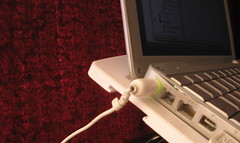
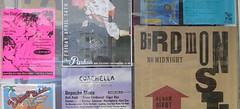
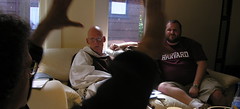
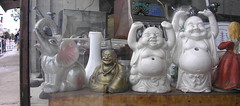

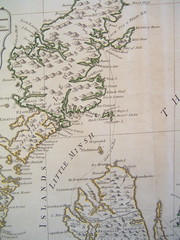



4 Comments:
Wonderful - it put me in mind of the objectification of the individual (and the underlying power relations contained in that objectification) inherent in pornography. I guess it is simply that the embarrassed glance away from engagement on the tube, is the obverse side of the coin of the desire to control, that is pornography. The dominance of masturbators on Chatroulette feels like a fragment of a coherent and familiar story.
I'm with you, and blame the railways.
Have we talked about Delaney's _Time Square Red/Time Square Blue_ yet? About the gentrification (Disney-fication) of Times Square and its impact on the DL men-who-have-'sex'-with-men world? But further, by removing these spaces, also removing the opportunity to touch, to gaze at total strangers? Cross-class, race, age, ability? What the suburbs do to touch?
<3
Your point about on-street interaction and guidebooks is something I've been thinking about lately-- I failed to print out maps before driving to Ithaca for my first visit, and thus ended up asking for directions many, many times. It's (apparently) harder to buy maps these days than it used to be, so my assumption that they'd be readily available in gas stations led to a lot of human interaction. By the end of the trip, I'd found maps, but was surprised to be grateful that it had taken me so long.
Post a Comment
<< Home